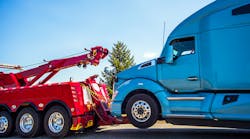Seven considerations for choosing outside service providers
Supply chain issues have left truck makers unable to produce enough vehicles to meet demand, meaning fleets must keep used equipment longer. Of course, older assets need more maintenance and repairs, and many fleets may not have the capacity or staff to take on more maintenance and repair work in their own shops.
Fleet managers looking to move maintenance and repair to outside service providers should consider these seven factors:
1. Triage system
Is there a triage system in place so that within two to four hours the shop can complete an initial diagnosis of the truck, tell you what the problem is, and indicate how long it will take to complete the repair? It may be beneficial if they have an express bay for repairs that take under four hours to avoid having to wait in a queue behind trucks with extensive repair needs.
2. Technicians
Do they have enough technicians on staff? Given the well-publicized technician shortage, this is a real concern. Beyond having the right number of technicians, ask about their skill sets and certifications specific to your repair. For example, ask if the tech doing the brake job is certified or ask about their training program.
3. Tools and equipment
Properly diagnosing and repairing a truck takes more than a skilled technician. A shop also needs a wide array of tools and equipment—especially electronic diagnostic tools—to get to the root cause of a problem and make the correct repair the first time.
4. Parts
What brand of parts are used? Is the service provider incentivized to pay the lowest price for parts (and part quality)? There is a balance between the part quality and price paid. Don’t shell out for a shop that uses cheap parts of inferior quality. Joe Puff, VP of truck technology and maintenance for NationaLease, recommends premium parts from quality manufacturers, not the cheapest parts available. Cheap, substandard quality parts can have a shorter life and can wreak havoc on many downstream systems. As a fleet owner, it’s important to focus on the total cost of ownership, not one shop bill at a time.
5. Labor Billing
How are they billing labor? Is it flat-rate, actual time, or by estimate? If it is actual time, how do you know the technician is efficient? What is the billing rate per hour?
6. References
Can they provide the names of several larger customers as references?
7. Insurance
What are the shop insurance limits? Is this adequate for the repairs you are having them complete?
Before you begin evaluating outside service providers, make sure you have a thorough understanding of your existing maintenance and repair operations, including its current cost. Armed with that information, you can begin evaluating outside service providers to find the one that best meshes with your needs.
Jane Clark is vice president of member services for NationaLease. In this position, she is focused on managing the member services operation as well as working to strengthen member relationships, reduce member costs, and improve collaboration within the NationaLease supporting groups. Prior to joining NationaLease, Clark served as area vice president for Randstad, one of the nation’s largest recruitment agencies, and before that, she served in management posts with QPS Cos., Pro Staff, and Manpower Inc.
This blog originally appeared on FleetOwner.com.



